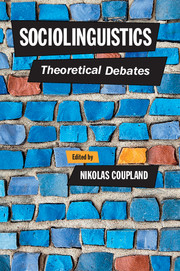Book contents
- Frontmatter
- Contents
- List of contributors
- Preface and acknowledgements
- 1 Introduction: Sociolinguistic theory and the practice of sociolinguistics
- Part I Theorising social meaning
- Part II Language, markets and materiality
- Part III Sociolinguistics, place and mobility
- Part IV Power, mediation and critical sociolinguistics
- Part V Sociolinguistics, contexts and impact
- Part VI The evolution of sociolinguistic theory
- 18 Succeeding waves: Seeking sociolinguistic theory for the twenty-first century
- 19 Language theory in contemporary sociolinguistics: Beyond Dell Hymes?
- 20 Five Ms for sociolinguistic change
- Index
- References
19 - Language theory in contemporary sociolinguistics: Beyond Dell Hymes?
from Part VI - The evolution of sociolinguistic theory
Published online by Cambridge University Press: 05 June 2016
- Frontmatter
- Contents
- List of contributors
- Preface and acknowledgements
- 1 Introduction: Sociolinguistic theory and the practice of sociolinguistics
- Part I Theorising social meaning
- Part II Language, markets and materiality
- Part III Sociolinguistics, place and mobility
- Part IV Power, mediation and critical sociolinguistics
- Part V Sociolinguistics, contexts and impact
- Part VI The evolution of sociolinguistic theory
- 18 Succeeding waves: Seeking sociolinguistic theory for the twenty-first century
- 19 Language theory in contemporary sociolinguistics: Beyond Dell Hymes?
- 20 Five Ms for sociolinguistic change
- Index
- References
Summary
Introduction
As a long-time reader and editorial board member of Language in Society (LiS) and its editor from 2005 to 2014, I have had the opportunity to observe changes in the field of sociolinguistics through the lens of its oldest journal. LiS was founded, in 1972, specifically to publish research related to “all the interrelations of language and social life” (Hymes 1972: 2). The journal's founding editor, Dell Hymes, hoped that the journal would help lead to “a reconstruction of social theory in the light of linguistic methods and findings, and of linguistic theory on a social basis” (p. 2). When it came to the latter of these goals, Hymes hoped for a “broad conception of language and its relevance” (p. 3), broader than that of the “central thread” of twentieth-century linguistic theory, with its focus on reference at the expense of other kinds of meaning, its insistence on the autonomy of levels of language (phonology, morphology, syntax, and semantics) and on the autonomy of language as an object of study, and its lack of attention to what people do with language (p. 3). Hymes hoped for an “integrative” theory of language that would question the very notions of “language” and “dialect” and that would start from the assumption that structure follows function rather than the other way around, as “the significance of features of language cannot be assessed without knowledge of their social matrix” (p. 5). This was not a modest set of aims. For Hymes, the goal of sociolinguistics, “if such research is to be more than a novel name for a hodge-podge of pre-existing activities, pursued helter-skelter,” was “to change the terms of reference for scientific, and informed public discussion, of ‘language’ … to put an end to theory and research in terms of ‘language’ and ‘languages,’ and to replace it by theory and research in terms of the true forms in which linguistic resources are organized, change and are changed, in human lives” (p. 10).
LiS has always been multidisciplinary. Its original associate editors were William Labov, a linguist, and Allan Grimshaw, a sociologist; Hymes had academic degrees in linguistics and anthropology and taught mainly in the latter field.
- Type
- Chapter
- Information
- SociolinguisticsTheoretical Debates, pp. 417 - 432Publisher: Cambridge University PressPrint publication year: 2016
References
- 6
- Cited by

